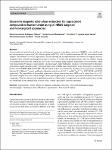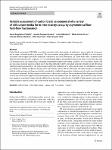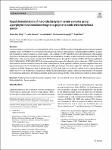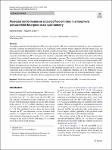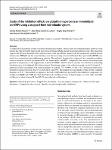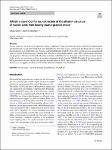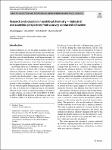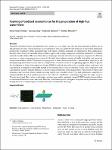Search
Author
- Carlos, Alegría (2)
- Carlos, Seara (2)
- David, Orden (2)
- Klaus, Bretterbauer (2)
- next >
Subject
Date issued
Has File(s)
- true (287)
Search Results
A new analytical method based on the use of dispersive magnetic solid-phase extraction (DMSPE) is described for the preconcentration of capsaicin (CAP), dihydrocapsaicin (DCAP), and N-vanillylnonanamide (PCAP) from human serum samples. The influence of several experimental factors affecting the adsorption (nature and amount of magnetic material, adsorption time, and pH) and desorption (nature of solvent, its volume and desorption time) steps was studied. Among seven different nanomaterials studied, the best results were obtained using magnetic multiwalled carbon nanotubes, which were characterized by means of spectrometry- and microscopy-based techniques. Analyses were performed by ultra-high-performance liquid chromatography with quadrupole-time-of-flight mass spectrometry using el... |
Carbon black nanomaterial (CB-NM), as an industrial product with a large number of applications, poses a high risk of exposure, and its impact on health needs to be assessed. The most common testing platform for engineered (E)NMs is in vitro toxicity assessment, which requires prior ENM dispersion, stabilization, and characterization in cell culture media. Here, asymmetric flow field-flow fractionation (AF4) coupled to UV–Vis and dynamic light scattering (DLS) detectors in series was used for the study of CB dispersions in cell culture media, optimizing instrumental variables and working conditions. It was possible to disperse CB in a non-ionic surfactant aqueous solution due to the steric effect provided by surfactant molecules attached on the CB surface which prevented agglomerati... |
An electrochemical sensor based on a screen-printed carbon electrode (SPCE) modified with porphyrin-functionalized magnetic graphene oxide (TCPP-MGO) was developed for the sensitive and selective determination of malondialdehyde (MDA), an important biomarker of oxidative damage, in serum samples. The coupling of TCPP with MGO allows the exploitation of the magnetic properties of the material for separation, preconcentration, and manipulation of analyte, which is selectively captured onto the TCPP-MGO surface. The electron-transfer capability in the SPCE was improved through derivatization of MDA with diaminonaphthalene (DAN) (MDA-DAN). TCPP-MGO-SPCEs have been employed to monitor the differential pulse voltammetry (DVP) levels of the whole material, which is related to the amount of... |
Atmospheric pressure field desorption (APFD) mass spectrometry (MS) has recently been explored as a new contribution to the field of ambient desorption/ionization (ADI). Depending on the selected polarity applied to the field emitter, ionic and polar analytes were demonstrated to deliver positive as well as negative ions. Whereas this recent study solely reported on the formation of even-electron ions of either polarity, the present work on APFD-MS demonstrates the abundant formation of positive molecular ions, M+•, from polycyclic aromatic compounds. Molecular ions were formed on and desorbed from standard 13-µm activated tungsten wire emitters at atmospheric pressure. |
A stopped-flow microfluidic system to monitor glutathione peroxidase (GPx) activity and evaluate potential inhibitors of the enzyme has been developed based on the integration of the microfluidic chip in the reaction/detection zone. This integration supposes the physical alignment at the optimal location of the microfluidic channel, both the magnetically retained enzyme microreactor (MREµR) and the remote luminescence detection using a focused bifurcated fiber optic bundle (BFOB) connected to a conventional spectrofluorometer detector. The method is based on the coupling of two competitive oxidative chemical reactions, in which glutathione (GSH) and homovanillic acid (HVA) competed for their interaction with hydrogen peroxide in the presence of the magnetically retained GPx-MNPs. |
Quinoxaline has recently gained interest as monomer in conjugated copolymers because of its easy synthetic accessibility and successful use in highly efficient organic solar cells. In this contribution, we introduce a quinoxaline–fluorene-co-polymer, PFQ10, synthesized by copolymerization of 5,8-dibromo-6,7-difluoro-2-[(2-hexyldecyl)oxy]quinoxaline and 9,9-dioctyl-9H-9-fluorene-2,7-bis(boronic acid pinacol ester) using the Suzuki–Miyaura reaction. By optimization of the reaction conditions, polymers with molecular weights up to 17.2 kDa and a low dispersity of 1.3 were obtained. PFQ10 showed blue photoluminescence with an emission maximum at 459 nm and a relative fluorescence quantum yield of 0.37. As proof of principle, PFQ10 was employed in organic light-emitting diodes and showed... |
Nucleic acids are one of the most important cellular components. These molecules have been studied both experimentally and theoretically. As all-atom simulations are still limited to short time scales, coarse-grain modeling allows to study of those molecules on a longer time scale. Nucleic-Acid united RESidue (NARES-2P) is a low-resolution coarse-grained model with two centers of interaction per repeating unit. It has been successfully applied to study DNA self-assembly and telomeric properties. This force field enables the study of nucleic acids Behavior on a long time scale but lacks atomistic details. In this article, we present new software to reconstruct atomistic details from the NARES-2P model. It has been applied to RNA pseudoknot, nucleic acid four-way junction, G-quadruple... |
Analytical chemistry is a sub-discipline of chemistry that even young schoolchildren encounter at an early stage in their education. Gravimetry and measurement uncertainties are aspects that form a part of such education, as well as measurements of pH and colorimetry. These are all an integral part of children’s early educational experiences, which shows the importance of this discipline within the wider context of natural science. |
Treatment of polluted water is an important task to secure access to clean water also for future generations. Filters are an efficient means to reject various pollutants on a wide range of size scales either by size-exclusion or electrostatic interaction, respectively. Commonly, filters and membranes from various synthetic materials are employed for these applications. Recently, filters based on renewable (nano) cellulose papers and coatings emerged as sustainable alternative to synthetic materials usually utilized. However, fabrication of such paper network structures from aqueous suspension by filtration processes is a time-consuming process caused by the high water holding capacity of highly hydrophilic and negatively charged nanocellulose fibrils. |
Differential scanning calorimetry (DSC) was used as an efficient and rapid tool in studying the conformational transitions between the folded and unfolded structures of cellulolytic enzymes. The thermal properties of two crude hydrolytic enzyme cocktails containing extracellular cellulases from Trichoderma longibrachiatum DIBAF-10 were analyzed and compared with three commercial cellulase preparations. Differences in the thermal behavior of fungal cellulases in the liquid phase, freeze-dried state, liquid formulations in sodium citrate buffer (pH 4.8), and contact with cellulose, carboxymethyl cellulose, and cellobiose were evaluated. DSC profiles of cellulases from the DIBAF-10 strain provided important thermodynamic information about the thermal stability of the included proteins.... |

